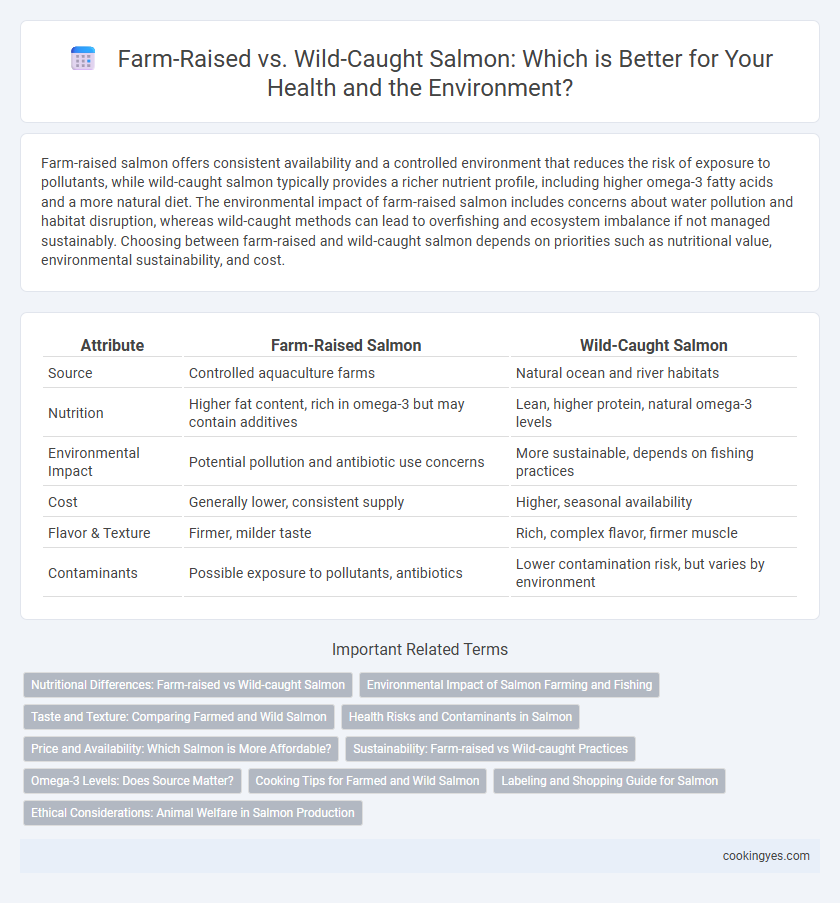Farm-raised salmon offers consistent availability and a controlled environment that reduces the risk of exposure to pollutants, while wild-caught salmon typically provides a richer nutrient profile, including higher omega-3 fatty acids and a more natural diet. The environmental impact of farm-raised salmon includes concerns about water pollution and habitat disruption, whereas wild-caught methods can lead to overfishing and ecosystem imbalance if not managed sustainably. Choosing between farm-raised and wild-caught salmon depends on priorities such as nutritional value, environmental sustainability, and cost.
Table of Comparison
| Attribute | Farm-Raised Salmon | Wild-Caught Salmon |
|---|---|---|
| Source | Controlled aquaculture farms | Natural ocean and river habitats |
| Nutrition | Higher fat content, rich in omega-3 but may contain additives | Lean, higher protein, natural omega-3 levels |
| Environmental Impact | Potential pollution and antibiotic use concerns | More sustainable, depends on fishing practices |
| Cost | Generally lower, consistent supply | Higher, seasonal availability |
| Flavor & Texture | Firmer, milder taste | Rich, complex flavor, firmer muscle |
| Contaminants | Possible exposure to pollutants, antibiotics | Lower contamination risk, but varies by environment |
Nutritional Differences: Farm-raised vs Wild-caught Salmon
Farm-raised salmon typically contains higher levels of Omega-6 fatty acids and a slightly lower concentration of Omega-3 fatty acids compared to wild-caught salmon, impacting their overall lipid profile. Wild-caught salmon offers a richer source of antioxidants like astaxanthin, which contributes to its deeper color and potential health benefits. Both types provide essential nutrients such as protein and vitamin D, but wild-caught salmon generally has lower contaminant levels and a more favorable fatty acid ratio for cardiovascular health.
Environmental Impact of Salmon Farming and Fishing
Salmon farming often leads to habitat disruption, water pollution, and the spread of diseases to wild populations, raising concerns about ecosystem health. Wild-caught salmon fisheries, while generally having a lower carbon footprint, can still contribute to overfishing and affect marine biodiversity if unmanaged. Sustainable practices in both farm-raised and wild-caught salmon industries are crucial to minimizing environmental impact and preserving aquatic ecosystems.
Taste and Texture: Comparing Farmed and Wild Salmon
Farm-raised salmon typically has a milder flavor and a softer, fattier texture due to higher omega-3 fatty acid content and controlled diet. Wild-caught salmon offers a more robust, distinct taste with a firmer, leaner texture resulting from natural diet and active lifestyle. Differences in taste and texture are influenced by environmental factors and nutritional variations between farmed and wild salmon.
Health Risks and Contaminants in Salmon
Farm-raised salmon often contain higher levels of contaminants such as PCBs, dioxins, and antibiotics compared to wild-caught salmon, posing potential health risks to consumers. Wild-caught salmon generally have lower contaminant levels due to their natural diet and environment, reducing exposure to harmful substances. Consumers concerned about toxins should consider sourcing wild-caught salmon or verified low-contaminant farm-raised options to minimize health risks.
Price and Availability: Which Salmon is More Affordable?
Farm-raised salmon is generally more affordable due to controlled breeding and year-round availability, resulting in lower prices compared to wild-caught salmon. Wild-caught salmon prices fluctuate seasonally and tend to be higher because of limited supply and the costs of sustainable harvesting. Consumers seeking budget-friendly options often prefer farm-raised salmon, while availability of wild-caught salmon is concentrated during specific fishing seasons.
Sustainability: Farm-raised vs Wild-caught Practices
Farm-raised salmon relies on controlled aquaculture systems that reduce overfishing and habitat disruption but may contribute to water pollution and resource consumption. Wild-caught salmon supports natural ecosystems and biodiversity but faces risks from overharvesting and climate change impacts on spawning grounds. Sustainable practices prioritize minimizing environmental impact through responsible management and certifications like ASC for farm-raised and MSC for wild-caught salmon.
Omega-3 Levels: Does Source Matter?
Farm-raised salmon generally contains higher levels of omega-3 fatty acids compared to wild-caught salmon due to controlled diets rich in omega-3 sources like fish oil and flaxseed. Wild-caught salmon, however, offers a more variable omega-3 content influenced by their natural diet and environment, often resulting in lower but still beneficial levels. Understanding these differences is crucial for consumers prioritizing omega-3 intake for cardiovascular and cognitive health benefits.
Cooking Tips for Farmed and Wild Salmon
Farm-raised salmon typically contains higher fat content, making it ideal for grilling or pan-searing to achieve a moist, flavorful result. Wild-caught salmon has leaner flesh, requiring careful temperature control and shorter cooking times to prevent drying out. Both types benefit from seasoning with herbs like dill and citrus to enhance their natural flavors while maintaining texture.
Labeling and Shopping Guide for Salmon
Farm-raised salmon are often labeled with certifications such as ASC (Aquaculture Stewardship Council) or Best Aquaculture Practices (BAP), indicating responsible farming methods, while wild-caught salmon typically carries labels like MSC (Marine Stewardship Council) to verify sustainable fishing sources. When shopping for salmon, consumers should examine these labels to ensure traceability, quality, and sustainability, with wild-caught varieties usually featuring a higher omega-3 content and more robust flavor profile. Price differences also exist; farm-raised salmon is generally more affordable and widely available year-round, whereas wild-caught salmon prices fluctuate seasonally and by region.
Ethical Considerations: Animal Welfare in Salmon Production
Farm-raised salmon often face ethical concerns due to crowded conditions that can lead to disease and stress, impacting overall animal welfare. Wild-caught salmon experience natural habitats and behaviors but encounter risks from overfishing and environmental disruptions. Evaluating animal welfare in salmon production requires balancing the health of farm operations with the sustainability of wild populations.
Farm-raised vs Wild-caught for salmon Infographic

 cookingyes.com
cookingyes.com